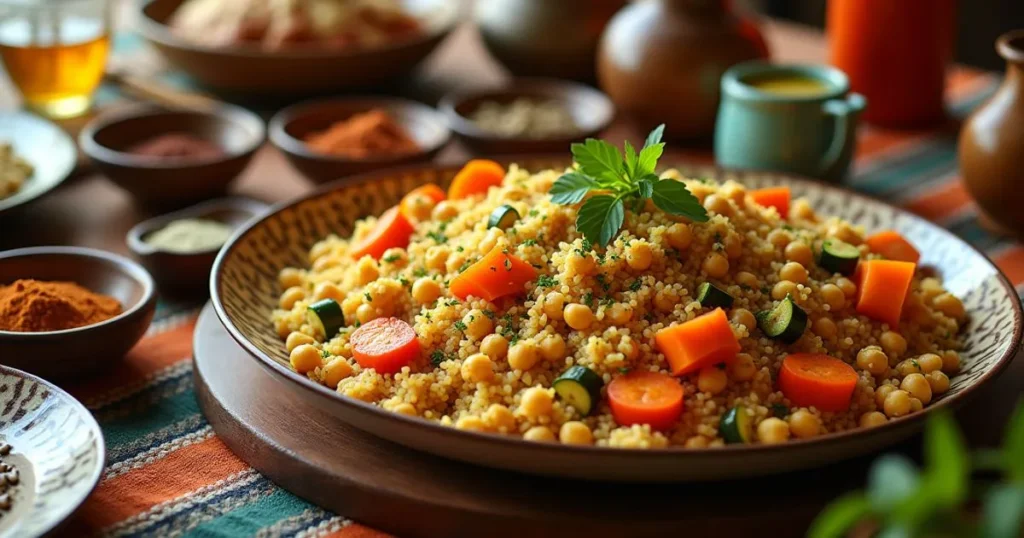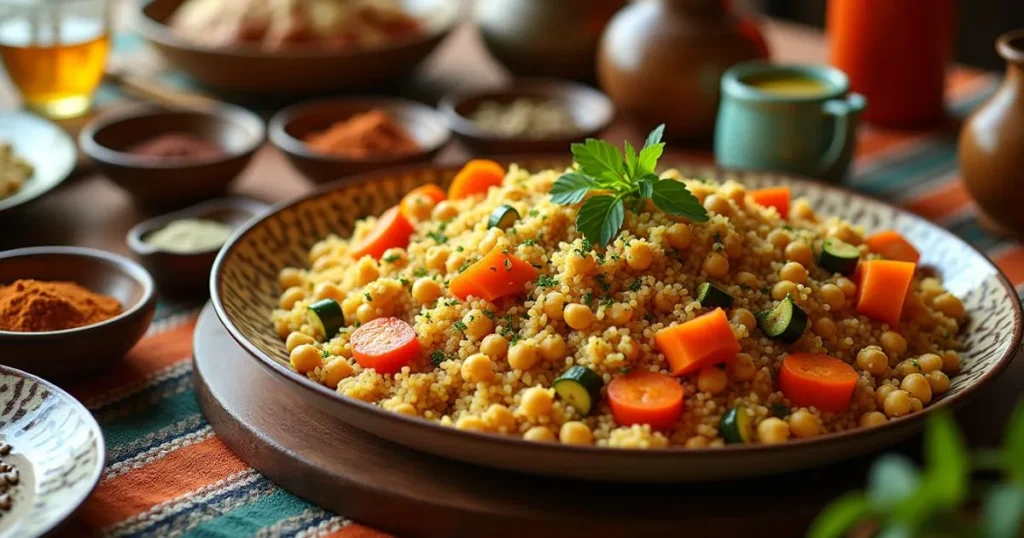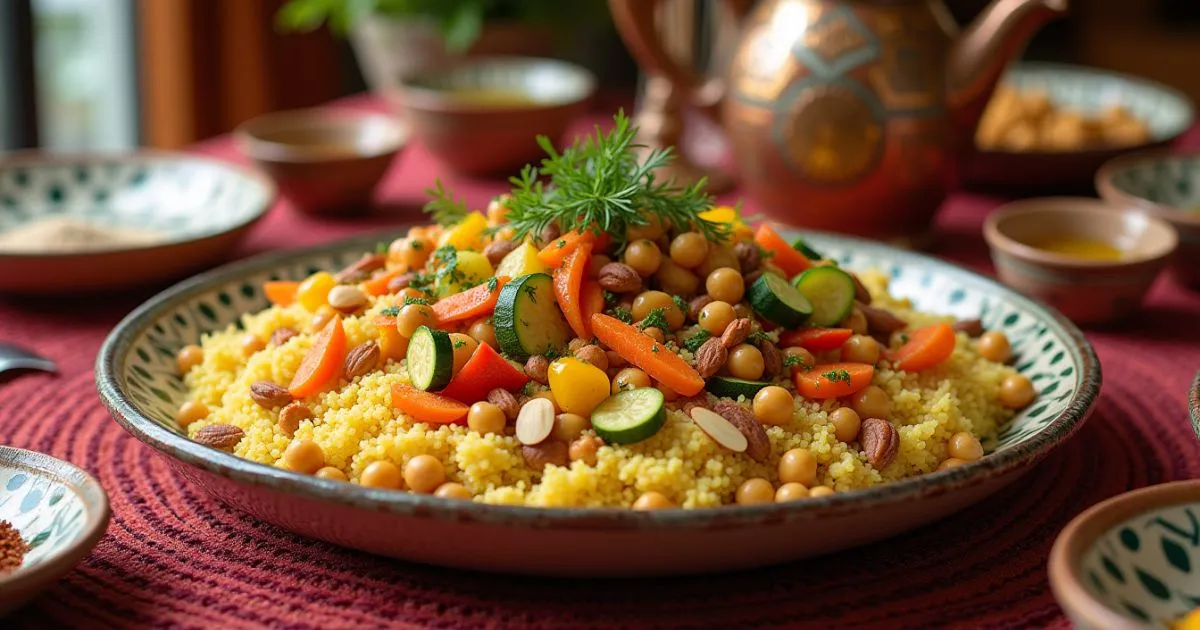Table of Contents
The Heartwarming Magic of Moroccan Couscous
Imagine the aroma of warm spices drifting through your kitchen, the gentle steam rising from a bowl of golden grains, and the laughter of friends and family gathered around your table. Moroccan couscous isn’t just a dish—it’s a celebration of togetherness, comfort, and tradition. Whether you’re reminiscing about a trip to Marrakech or simply craving a nourishing meal, learning how to make fluffy Moroccan couscous at home brings a piece of Morocco’s vibrant culture right to your plate.
If you’ve ever struggled with sticky, clumpy couscous or wondered how to achieve that light, airy texture you’ve tasted in authentic Moroccan homes, you’re in the right place. This guide will walk you through every step, from selecting the right ingredients to serving your masterpiece with pride. Let’s embark on this culinary journey together and unlock the secrets to perfect Moroccan couscous.
What Makes Moroccan Couscous So Special?
It is more than just a side dish—it’s a symbol of hospitality and heritage. In Morocco, couscous is often the centerpiece of Friday family gatherings, weddings, and festive occasions. Its roots stretch back centuries, with each region and family adding their own twist to the recipe.
The Unique Qualities of Moroccan Couscous
- Fine Texture: Unlike Palestine or Lebanese couscous, it’s made from tiny, fine granules of semolina wheat. This gives it a delicate, fluffy texture when prepared correctly.
- Versatility: You can serve it with a variety of vegetables, meats, or even as a sweet dish with dried fruits and nuts.
- Cultural Significance: Sharing couscous is a cherished tradition, symbolizing unity and abundance.
Moroccan Couscous vs. Other Types
- Moroccan Couscous: Smallest granules, cooks quickly, light and fluffy.
- Israeli (Pearl) Couscous: Larger, pearl-like balls, chewier texture.
- Lebanese (Moghrabieh) Couscous: Even larger, almost like small pasta.
Achieving the perfect fluffiness is the hallmark of authentic Moroccan couscous. Mastering this recipe goes beyond simply following instructions; it’s about appreciating the method and honoring its cultural roots.

Essential Ingredients for Fluffy Moroccan Couscous
Before you begin, gather your ingredients. The quality and freshness of each component will make a noticeable difference in your final dish.
Ingredients Table
| Ingredient | Quantity | Notes |
|---|---|---|
| Moroccan couscous | 2 cups | Fine or medium grain |
| Water | 2 cups | Boiling |
| Olive oil | 2 tbsp | Extra virgin preferred |
| Salt | 1 tsp | Adjust to taste |
| Butter | 2 tbsp | Optional, for extra richness |
| Saffron threads | Pinch | Optional, for aroma/color |
| Vegetables | As desired | Carrots, zucchini, etc. |
| Chickpeas | 1 cup | Cooked, optional |
| Spices | To taste | Cumin, coriander, cinnamon |
Ingredient Insights
- Moroccan Couscous: Look for fine or medium-grain couscous at specialty stores or online. Avoid instant couscous if you want the most authentic texture.
- Olive Oil & Butter: These add richness and help separate the grains.
- Saffron: A pinch of saffron infuses the couscous with a subtle aroma and golden hue.
- Vegetables & Chickpeas: A classic couscous platter usually features a colorful array of steamed vegetables paired with soft, flavorful chickpeas.
- Spices: Cumin, coriander, and cinnamon are classic, but you can adjust to your taste.
Step-by-Step Guide: How to Make Fluffy Moroccan Couscous
Ready to transform simple ingredients into a show-stopping dish? Follow these steps for guaranteed success.
Preparing the Couscous
- Measure and Rinse: Place 2 cups of couscous in a large bowl. Rinse briefly with cold water and drain well. This removes excess starch and prevents clumping.
- Season: Add 1 teaspoon of salt and 2 tablespoons of olive oil. Toss to coat the grains evenly.
- First Steaming: Pour 2 cups of boiling water over the couscous. Cover tightly with a lid or plastic wrap. Let it steam for 10 minutes.
- Fluff: Uncover and gently fluff the couscous with a fork, breaking up any lumps. Add 2 tablespoons of butter (if using) and mix well.
- Second Steaming (Optional for Extra Fluffiness): For an even lighter texture, transfer the couscous to a steamer basket or colander lined with cheesecloth. Steam over simmering water for another 10 minutes, then fluff again.
Cooking the Vegetables and Protein (Optional)
While your couscous steams, prepare the toppings:
- Vegetables: Slice carrots, zucchini, and bell peppers. Steam or sauté until tender.
- Chickpeas: Rinse and warm cooked chickpeas.
- Protein: For a heartier meal, add braised lamb, chicken, or even fish. Season with Moroccan spices for authenticity.
Fluffing and Serving Moroccan Couscous
- Final Fluff: Use a fork to gently separate the grains. Avoid pressing or stirring vigorously, which can make the couscous dense.
- Mix-Ins: Drizzle with a little more olive oil or melted butter for shine and flavor.
- Presentation: Mound the couscous on a large platter. Arrange vegetables and protein on top. Garnish with fresh herbs, toasted almonds, or dried fruit for a festive touch.
Quick Reference: Steps to Fluffy Moroccan Couscous
- Measure and rinse couscous
- Season with salt and oil
- Pour boiling water, cover, and steam
- Fluff with fork, add butter, and steam again if desired
- Serve with your favorite toppings

Tips and Tricks for Perfect Moroccan Couscous Every Time
Even seasoned cooks can run into trouble with couscous. Here’s how to avoid common pitfalls and ensure your dish turns out perfectly every time.
- Don’t Overcook: Couscous cooks quickly. Leaving it covered for too long can make it mushy.
- Use the Right Ratio: Stick to a 1:1 ratio of couscous to water for the best texture.
- Fluff, Don’t Stir: Always use a fork to fluff, never a spoon.
- Add Flavor: Infuse your water with saffron or a cinnamon stick for extra depth.
- Reheat Gently: When preparing couscous in advance, revive it by adding a bit of water and gently fluffing it as you warm it up.
Make-Ahead and Storage Tips
- Make-Ahead: Couscous can be prepared a day in advance. Store in an airtight container in the fridge.
- Reheating: Sprinkle with a little water, cover, and microwave or steam until warm. Fluff before serving.
- Freezing: Couscous freezes well. Thaw overnight in the fridge and reheat as above.
Serving Suggestions: What to Eat with Moroccan Couscous
It’s incredibly versatile. Here are some classic and creative ways to enjoy it:
Traditional Pairings
- Tagine: Serve couscous alongside a slow-cooked lamb or chicken tagine with apricots and almonds.
- Vegetable Stew: For a hearty option, spoon over a rich stew of carrots, zucchini, and chickpeas, all simmered together in a fragrant, spiced tomato base.
- Grilled Meats: Pair with skewers of spiced beef, chicken, or lamb.
Vegetarian and Vegan Options
- Roasted Vegetables: Toss couscous with roasted eggplant, bell peppers, and cherry tomatoes.
- Chickpea Salad: Mix with chickpeas, fresh herbs, lemon juice, and olive oil for a protein-packed salad.
- Stuffed Peppers: Use couscous as a filling for bell peppers, along with raisins and pine nuts.
Garnishes and Extras
- Fresh Herbs: Mint, cilantro, and parsley add brightness.
- Toasted Nuts: Almonds, pine nuts, or pistachios for crunch.
- Dried Fruit: Raisins, apricots, or dates for a touch of sweetness.
- Yogurt Sauce: A dollop of plain yogurt with lemon zest complements the spices.
Frequently Asked Questions About Moroccan Couscous
What is the secret to fluffy Moroccan couscous?
The secret lies in proper steaming and gentle fluffing. Rinsing the grains, using the right water-to-couscous ratio, and fluffing with a fork after steaming ensures each grain stays separate and light.
Can I make Moroccan couscous gluten-free?
While authentic couscous uses wheat, you can easily swap in gluten-free alternatives such as millet or quinoa for a similar experience. The texture will differ, but you can still enjoy similar flavors and toppings.
How do I store leftover Moroccan couscous?
Store leftover couscous in an airtight container in the refrigerator for up to three days. To bring leftover couscous back to life, moisten it with a splash of water, heat it slowly, and use a fork to separate the grains.
What vegetables work best in a Moroccan couscous recipe?
Classic choices include carrots, zucchini, bell peppers, and chickpeas. You can also add pumpkin, turnips, or sweet potatoes for variety.
Is Moroccan couscous healthy?
Absolutely! Couscous is low in fat, a good source of fiber, and provides plant-based protein. When paired with vegetables and lean protein, it makes a balanced, nutritious meal.
Conclusion: Bring Moroccan Tradition to Your Table
You now have the knowledge and confidence to create fluffy couscous that rivals any you’d find in a Moroccan home. This dish is more than a recipe—it’s an invitation to connect with tradition, savor new flavors, and share memorable meals with those you love.
Don’t be afraid to make this recipe your own. Experiment with different vegetables, proteins, and spices. Share your creations with friends and family, and let the spirit of Moroccan hospitality fill your home.
Ready to try this fluffy couscous recipe? Gather your ingredients, follow these steps, and experience the magic for yourself. If you have questions, tips, or want to share your results, leave a comment below. Your feedback and stories help build a community of passionate home cooks—just like you!
Enjoy your culinary adventure, and may every bite transport you to the heart of Morocco!

